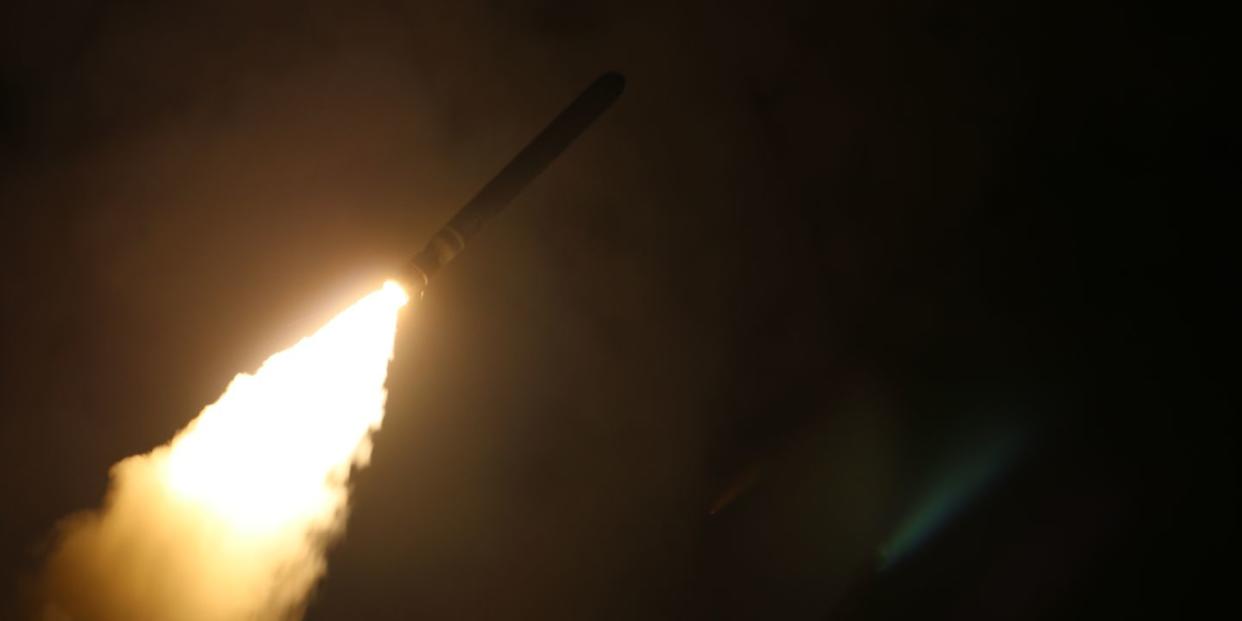The U.S. Finally Sold 400 Tomahawk Missiles to Japan. Here's Why.

Tokyo is rolling back restrictions on its armed forces with a newly announced procurement of Tomahawk land-attack cruise missiles that it hopes will give the island nation a counter-strike capability, should it be assailed by China or North Korea’s large nearby arsenals of land-based missiles. This is part of a recent large increase in Japanese defense spending, which has manifested in forthcoming platforms including new aircraft carriers and domestic stealth fighters.
Prime Minister Fumio Kishida announced plans to purchase 400 Tomahawks on Monday. This capability would become operational by 2026-2027. Already, Japan had set aside 211.3 billion yen ($1.55 billion USD) to got to such a purchase, which will proceed via the U.S.’s Foreign Military Sales (FMS) program. A 2019 U.S. order of Tomhawks, also known as TLAMS, averaged a price of $1.35 million per missile, but there will surely be ‘overhead’ training and equipment costs involved in introducing the missile into Japanese service.
That’s only part of the $37 billion Tokyo plans to spend by 2026 on standoff-range counter-strike weapons. The Tomahawks are effectively a stop gap until a forthcoming new surface-attack version of the indigenous Type 12 anti-ship missiles with range extended 750-900 miles enters service. This Type 12 Kai missile would have wider wings, allowing it to fly higher and thereby maximize range, while sporting a reduced radar cross-section to reduce losses to air defenses.
At least 2,1913 BGM-109 Tomahawk cruise missiles have been fired in combat since entering service in 1983. Powered by an F107 turbofan engine, the latest Block IV and V models have a range exceeding 1,000 miles, and can blast targets with a massive half-ton of explosives. Former nuclear-armed BGM-109A and BGM-109 Tomahawks have been retired, however.
Using a combination of inertial navigation and terrain contour-mapping, a TLAM can land within 10 meters of a designated target, or .1 meter if assisted with GPS. These weapons approach their targets at a maximum speed of 567 miles per hour, usually skimming at an altitude of only 100-165 feet to delay visibility on radar.
While the Tomahawk isn’t as stealthy or fast as some modern successors, it’s been heavily improved over the years. The Block IV model can now transmit video imagery while traveling to target, perform maneuvers to evade defenses while in transit, loiter overhead waiting for a signal to attack, and can be retargeted or instructed to abort the attack midflight—options that might reassure Japanese officials.
The latest Block V model re-introduces anti-ship capability in a subvariant called the Block Va Maritime Strike Tomahawk, integrating a radar seeker that enables it to home in on moving ships. There’s also a Block Vb with an advanced JMEWS warhead capable of bunker-busting penetrating strikes on underground missile silos and WMD facilities.
So far, the United Kingdom has been the Tomahawk’s only foreign operator, employing them from Royal Navy submarines. However, Canadian CSC frigates and Australian Hobart-class destroyers are also planned to eventually deploy these long-range land attack weapons.
Tokyo’s inquiries on purchasing Tomahawks back in 2013 were initially coolly received due to fears of aggravating China. However, given worsened US-China military tensions—particularly over Taiwan, which Japan also seeks to aid—and reinvigorated U.S. Japanese security ties, the Biden administration was much warmer to the idea while negotiating the Tomahawk sale in the fall of 2022.
One question remains the choice of launch platform, as air-, sea-, submarine- and land-based options reportedly were considered. The cheapest option would be land-based trucks, but warships and aircraft would effectively expand the range and possible approach vectors of Japan’s Tomahawks. Presently, reports suggest they’ll begin deployment on Japan’s powerful destroyers, which already come with the same Mark 41 Vertical Launch Systems used by U.S. Navy ships to launch Tomahawks and many other types of missiles.
Japan’s military also is reportedly planning to build a ‘test boat’ to study equipping Japanese submarines to fire Tomahawks. Unless Japan builds a new class of cruise missile submarines with vertical launch cells, these would have to be launched horizontally from torpedo tubes, permitting only a low-volume attack. Still, stealthy submarines can launch attacks from unexpected directions, confounding air defenses.
Offense: the best form of defense?
Post-World War II, Japan’s armed forces have been legally forbidden from using force outside of self-defense of Japanese soil, even in event of an attack on nearby allies. It has thus avoided procurement of weapons systems like aircraft carriers deemed to have mostly offensive missions. However, increasing tensions with North Korea and China’s rapidly improving military have complicated Japan’s self defense stance.
Both China and North Korea possess large arsenals of land-based ballistic missiles (and cruise missiles and hypersonic glide vehicles) that would could be unleashed to destructive effect against Japan in event of a high-intensity conflict. Notably, should the U.S. come into conflict with North Korea or China, Japanese airbases hosting U.S. military aircraft would probably come under attack—a scenario that may cause Tokyo to retaliate militarily.
Despite upgrades to Japanese air defense, including huge warships dedicated to ballistic missile defense using SM-3 missiles, likely some attacks would get through and potentially wreak great destruction. In a recent simulation of an attempted Chinese invasion of Taiwan, missile attacks on Japanese bases destroyed hundreds of American and Japanese combat aircraft on the ground.
In response to this threat, there have been increasing calls in Tokyo to field a “counter-strike capability” that could put China and North Korea’s missile launchers at risk. This is the sort of weapon that Japan has traditionally eschewed, because it means directing attacks on the soil of another country—but it’s hard to adhere to that standard when modern surface-to-surface missiles can inflict so much damage even without resorting to nuclear warheads.
You Might Also Like

